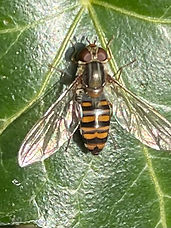
Pollinator Learning Zone
May 2022
THE DANDELION
A brilliant flower for pollinators, a hardy perennial that has a long flowering season, interesting seed heads and edible – You may have spent all your life persecuting the dandelion, but can you give them a second chance in your garden?
HOVERFLIES
Hoverflies are a beautiful and often overlooked type of pollinator. A simple way of encouraging hoverflies with an aquatic life stage into your garden is to make a hoverfly lagoon. Put a container filled with grass cuttings, leaves and water in a shady spot. This is the perfect habitat for hoverfly ‘rat-tailed’ larvae. For more info and to join the hoverfly lagoon project with Sussex University. https://www.thebuzzclub.uk/hoverfly-lagoons
Hoverflies are true flies (Diptera) but are often mistaken for bees because of their yellow-and-black patterns. This is no accident, since hoverflies mimic bees and wasps for defence, pretending they can sting. Here are the easiest ways to tell the difference.



BEE OR FLY?

BUMBLEBEE LIFECYCLE
The Lifecycle of the Bumblebee is quite different than a honeybee even though they are both social insects. In the Spring large queens emerge from hibernation feed on pollen and nectar and find a nest site. Here she lays eggs which develop into female worker bees. By summer the workers have taken over foraging for food and caring for eggs and larvae. The queen then remains in the nest where she will lay eggs until she dies. By late summer some eggs develop into Males and new queens, which leave the nest to feed and mate. The males and workers then die, leaving only the mated queens to hibernate over the winter and begin the lifecycle again.
BUZZ POLLINATION - ONLY BUMBLEBEES CAN DO THIS
Bumblebees have a special method of pollination that honeybees can’t do. It is called BUZZ pollination. This method is essential for example in blueberries, tomatoes, aubergines, and kiwis. Buzz pollination happens when the bumblebee contracts its flight muscles, which produce strong vibrations directed by their legs and mouthparts to release the pollen. So next time you see a bumblebee on your tomatoes listen out for a high-pitched noise as they BUZZ pollinate.
April 2022
The 270 species of bee that we have in the UK all fly at different times, so it is important to have food available for them all year round.
Many of the solitary bees are short-lived, after mating and egg-laying they’re gone before spring ends.
Bumblebees are around for much longer, the founding queens we see now will go onto produce broods of worker females then later in the year males and next year’s queens.
These are the bumblebees to look out for now are White-tailed bumblebee queens, Buff-tailed bumblebee queens, Tree bumblebee queens, Early bumblebee queens and Red-tailed bumblebee queens.
Solitary bees to look out for now are Gwynne’s Mining Bee, Tawny mining bee, Early mining bee, Clarke’s mining bee, Yellow-legged mining bee and the Hairy-footed flower bee.
The Red-tailed mason bee (Osmia bicolor) males emerge first and guard empty snail shells in their foraging grounds. The females which emerge later will make a nest within this shell, which they camouflage with ground litter. This has not been recorded in our parish but don’t tidy up those snail shells and you never know!
Now is a great time to look out for The Tawny Mining bee (Andrena fulva). The female bee is unmistakeable with a densely orange-furred abdomen and reddish pile on top of the thorax and is honeybee sized. They dig their nests into the ground often in garden lawns or flower beds. They feed on spring shrubs including willow, hawthorn, and fruit trees as well as dandelions.

Female Tawny Mining Bee
March 2022


Female Hairy-footed Flower Bee

Pollination (sexual reproduction in flowering plants) is one of the most important ecological processes on the planet, which supports both natural and agricultural ecosystems.
-
Lots of insects pollinate flowers as well as bees including flies, butterflies, moths, wasps, beetles, and midges.
-
There are over 270 species of bee in the UK - it’s not all about the domestic honeybee Apis mellifera.
-
There are 25 species of bumblebee in the UK. These large furry bees are the easiest group to recognise. They are a social bee living in colonies with a queen and ‘worker‘ females. 6 species are ‘cuckoo bumblebees’ that invade the nest of others and use the workers to raise their young.
-
There are over 250 species of solitary bees in the UK. They do not produce large colonies or hives and instead seek out aerial cavities or holes in the ground to create a nest.
-
Solitary bees are excellent pollinators because they are ‘messy’. Instead of having pollen baskets like bumblebees and honeybees they collect pollen all over their bodies.
-
Bumblebees spend the winter as hibernating queens (a few bumblebees can continue to be active during the winter). Solitary bees however spend the winter as larvae in holes eating stored pollen.
What to look out for now:
Big queen bumblebees coming out of hibernation, they will visit flowers to replenish their reserves before searching for a nest site such as an old mouse hole.
The Hairy-footed flower bee (Anthophora plumipes) is one of our largest solitary bees and one of the commonest bees of flowery gardens in spring. They are named after the hairs on the male’s legs that it uses to stroke the female. They are known to nest in cob walls.
If you would like a free cob bee brick to try and get the Hairy-footed Flower bee nesting in your garden please email Susan
Male Hairy-footed Flower Bee
